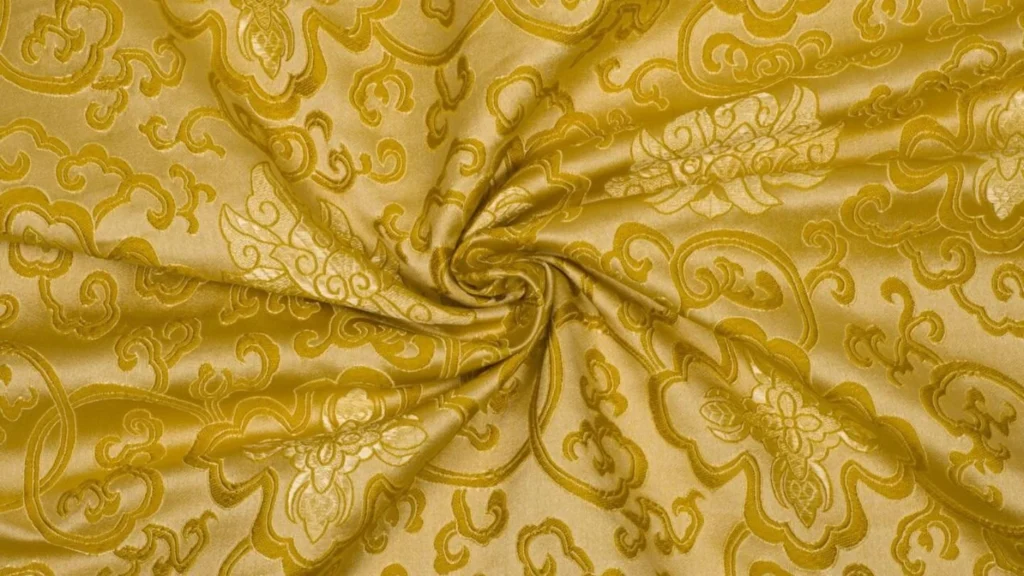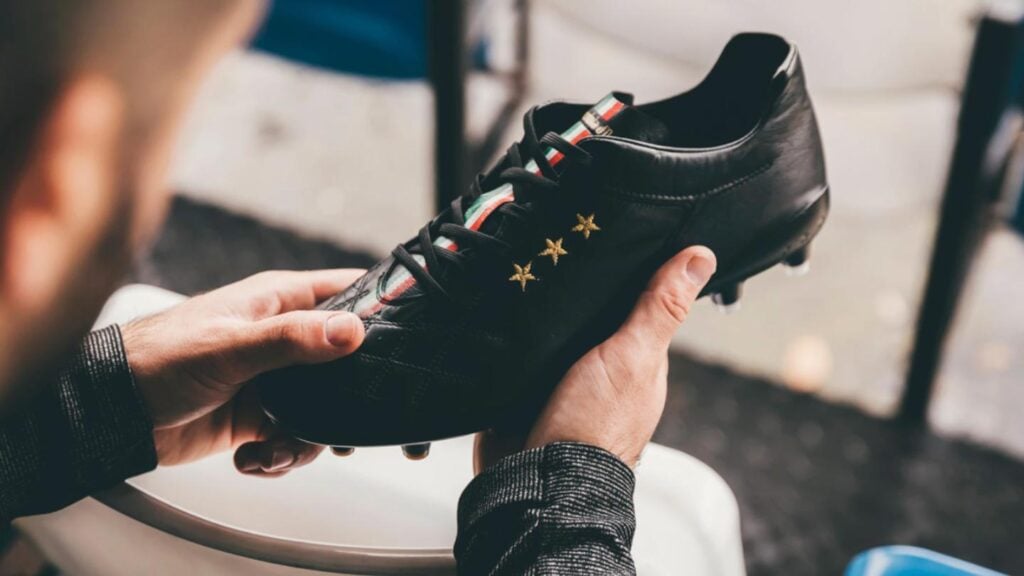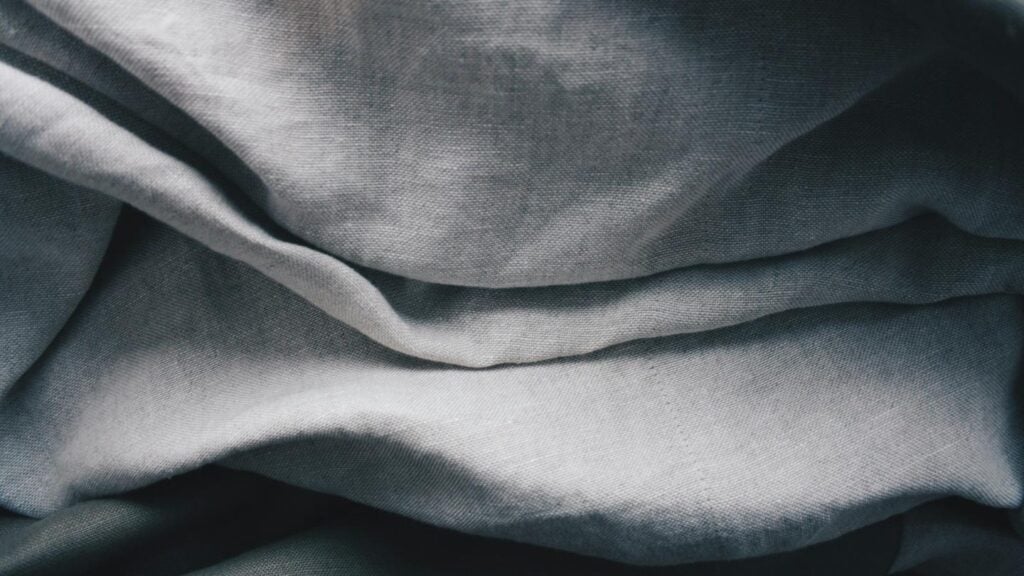2 – Baize Fabric Composition
3 – Baize Fabric vs Other Fabrics
4 – Baize Fabric Is Manufactured
5 – Common Uses in Fashion
6 – Understanding the Environmental Impact of Baize Fabric
7 – Exploring Price Points and Value for Money
8 – Conclusion
9 – FAQs
What is Baize Fabric?
Baize fabric is a strong, structured textile characterized by its distinctive diagonal weave—an attribute that places it within the family of twill fabrics. Recognized for its durability, subtle sheen, and resistance to wrinkles, Baize is commonly used in suiting, uniforms, formal jackets, and home furnishings. While it may not be a household name, Baize is a staple in professional tailoring and upholstery thanks to its performance and elegant appearance.
The term Baize often refers to a fabric woven with a pronounced twill pattern, typically using tightly twisted yarns. This construction gives it a smooth surface on one side and a more textured back—ideal for garments requiring both polish and structure. It is often confused with other twills, but what sets Baize apart is its uniform ribbing, medium-heavy weight, and its ability to drape cleanly without losing shape.
Depending on its intended use, Baize fabric can be made from:
- Wool, for refined suiting and cold-weather garments
- Polyester blends, for increased durability and lower maintenance
- Cotton or viscose, for lightweight, breathable versions used in casualwear or interior textiles

Here’s what makes Baize fabric particularly valued:
- Visual texture: The diagonal lines add depth and richness without bold patterns
- Wrinkle resistance: Twill weave helps the fabric maintain a polished look throughout the day
- Versatility: Suitable for both fashion (blazers, trousers) and function (military and school uniforms)
- Long-lasting: Stronger than plain weaves, making it ideal for daily wear
Though often hidden in plain sight, Baize fabric plays a vital role in both fashion and function—offering a blend of comfort, structure, and subtle sophistication. As we explore its origin, composition, and properties, you’ll understand why it continues to be a favorite among manufacturers and designers alike.
Baize Fabric Composition
The defining feature of Baize fabric is not the fiber itself, but the twill weave that gives the fabric its signature diagonal lines. However, the fibers used in its construction play a crucial role in determining the look, feel, and functionality of the final material. Different compositions are chosen based on the intended use of the fabric—whether for formalwear, workwear, or interior applications.
Common Fibers Used in Baize Fabric
- Wool: Baize made from wool is commonly used in suiting and outerwear. It offers excellent drape, natural warmth, and a refined appearance. Wool Baize is breathable and comfortable in cool weather but may require dry cleaning.
- Polyester and synthetic blends: These are widely used in Baize fabrics for uniforms, blazers, and affordable fashion. Polyester increases strength, wrinkle resistance, and color retention, making it ideal for garments that need to look polished all day. However, it tends to be less breathable than natural fibers.
- Cotton: When Baize is made from cotton, it becomes softer and more breathable—perfect for shirts, lightweight trousers, and casual jackets. Cotton Baize feels more relaxed and comfortable on the skin but can wrinkle more easily.
- Viscose (or rayon): Often added to blends to improve softness and drape. Viscose Baize feels smooth and flows nicely, making it suitable for linings or elegant clothing. It’s less durable on its own, so it’s usually paired with stronger fibers.
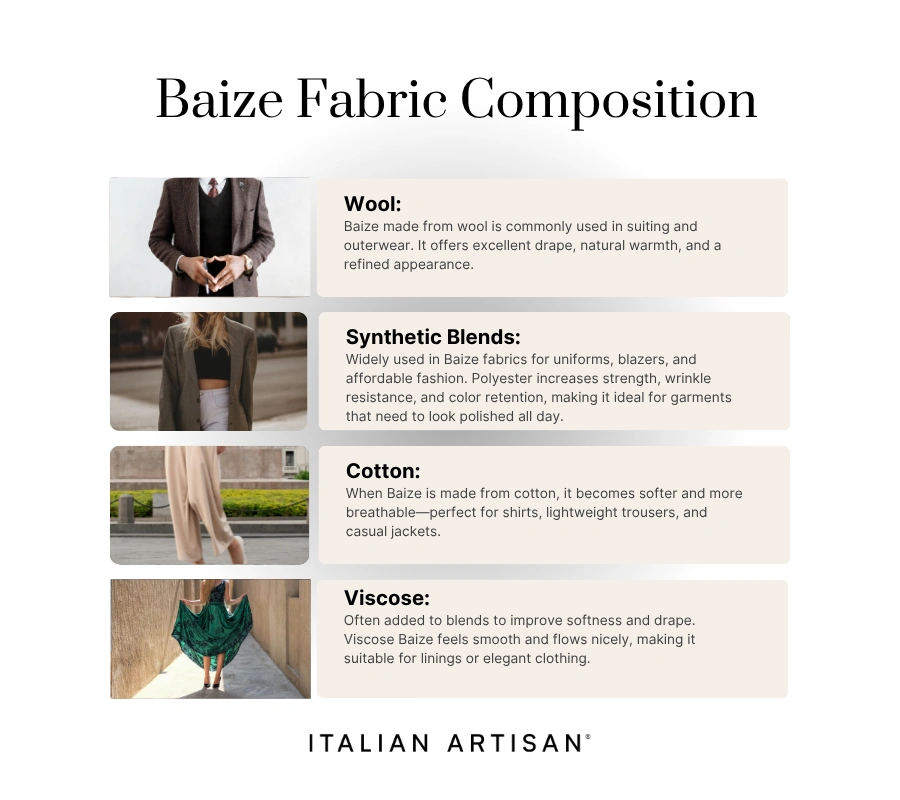
The Impact of Composition
The composition of Baize fabric determines key performance qualities such as:
- Drape – Wool and viscose offer natural elegance, while cotton feels more casual.
- Durability – Polyester and poly-blends are especially resistant to wear and tear.
- Care – Synthetic and cotton blends are usually machine-washable, while wool and viscose may need delicate treatment.
- Comfort – Natural fibers like cotton and wool allow the fabric to breathe, offering greater comfort throughout the day.
For example, a wool-polyester Baize blend is often used in uniforms because it holds its shape, resists wrinkles, and still offers a touch of refinement. A pure cotton version might be better for summer jackets or casual trousers, where comfort is a priority.
Understanding the Baize fabric composition is essential for making informed decisions—whether you’re designing a garment, sourcing material for a collection, or simply shopping with quality in mind.
Baize Fabric vs Other Fabrics
Baize fabric shares its twill weave with several other materials, but it stands out for its balance of structure, elegance, and durability. Here’s how it compares:
- vs Twill: Baize is a type of twill but typically more refined and tightly woven. It’s favored in formalwear for its crisp appearance and durability.
- vs Denim: Both use a diagonal weave, but denim is heavier, rougher, and more casual. Baize is smoother and better suited for tailored garments.
- vs Gabardine: Gabardine has a finer weave and softer drape, while Baize offers more structure—ideal for blazers, trousers, and uniforms.
- vs Canvas: Canvas is a plain weave, coarse, and heavy. Baize is softer and more polished, making it preferable for clothing rather than bags or utility items.
Why Choose Baize?
- Structured yet comfortable
- Resistant to wrinkles and wear
- Ideal for formal and uniform garments
- Elegant, clean finish
Baize finds its niche where durability meets sophistication—making it a go-to material in tailored fashion.
How Baize Fabric Is Manufactured
The production of Baize fabric starts with the selection of fibers—typically wool, cotton, polyester, or blends. These fibers are spun into yarns, which are then woven using a twill weave. This method involves passing the weft yarn over and under two or more warp yarns in a staggered pattern, creating the signature diagonal lines.
Key Steps in Manufacturing:
- Fiber selection: Depending on the desired texture, weight, and use, manufacturers choose between natural (like wool or cotton) and synthetic (like polyester) fibers.
- Yarn preparation: Fibers are combed, twisted, and dyed before weaving.
- Twill weaving: The loom is set up for a diagonal weave, which gives Baize its durability and smooth finish.
- Finishing: The fabric is treated through processes such as heat-setting, steaming, or chemical finishing to enhance performance (e.g. wrinkle resistance, softness, or water repellency).

Made in Italy Excellence
When produced in Italy, Baize often benefits from artisanal expertise, sustainable practices, and strict quality control. Italian manufacturers are known for creating Baize fabrics with superior drape, longevity, and refined texture—making them highly valued in luxury fashion.
Produce your fashion collection with us
Common Uses in Fashion
Baize fabric is widely used in fashion where structure, durability, and a clean finish are essential. Its twill weave and versatile composition make it ideal for garments that need to hold their shape while remaining comfortable to wear.
Key Applications:
- Tailored suits and blazers: Baize offers a crisp, professional look with excellent drape—ideal for business wear and uniforms.
- Trousers and skirts: Its medium to heavy weight makes it perfect for structured bottoms that resist wrinkling and wear.
- Outerwear: Wool or blended Baize is often used in coats and jackets for warmth, durability, and a polished appearance.
- Uniforms: Military, school, and corporate uniforms use Baize for its longevity and ability to maintain a neat look over time.
- Interior design: Heavier Baize fabrics are used for upholstery, curtains, and cushions, where strength and form retention are priorities.
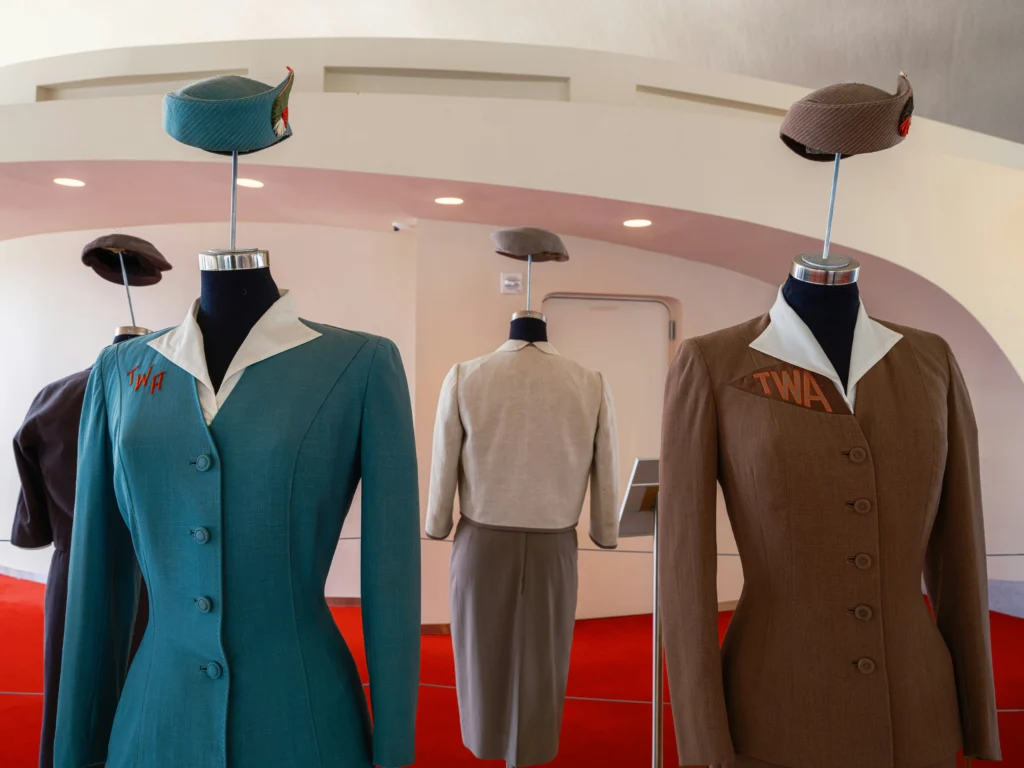
Designers choose Baize when they need a fabric that combines refinement with resilience—especially in garments meant to last through regular use while keeping a tailored silhouette.
Understanding the Environmental Impact of Baize Fabric
The environmental impact of Baize fabric depends largely on the fibers used in its production. Since Baize refers to the weave rather than a specific material, its sustainability can vary significantly.
Natural vs Synthetic Fibers
- Natural fibers like wool and cotton are biodegradable and renewable but require significant water, land, and energy—especially in cotton farming or sheep raising.
- Synthetic fibers like polyester are made from petroleum and are not biodegradable. However, they are durable and often require less frequent washing or replacement.
Key Environmental Considerations:
- Water usage: Cotton-based Baize consumes large amounts of water, especially if not organically grown.
- Energy consumption: Synthetic Baize (polyester blends) requires high energy input during fiber production but may offset this with a longer lifespan.
- Chemical treatments: Some finishing processes involve dyes or coatings that can be harmful if not properly managed.
- Recyclability: Mono-material Baize is easier to recycle, while blended fabrics pose challenges unless specific technologies are used.
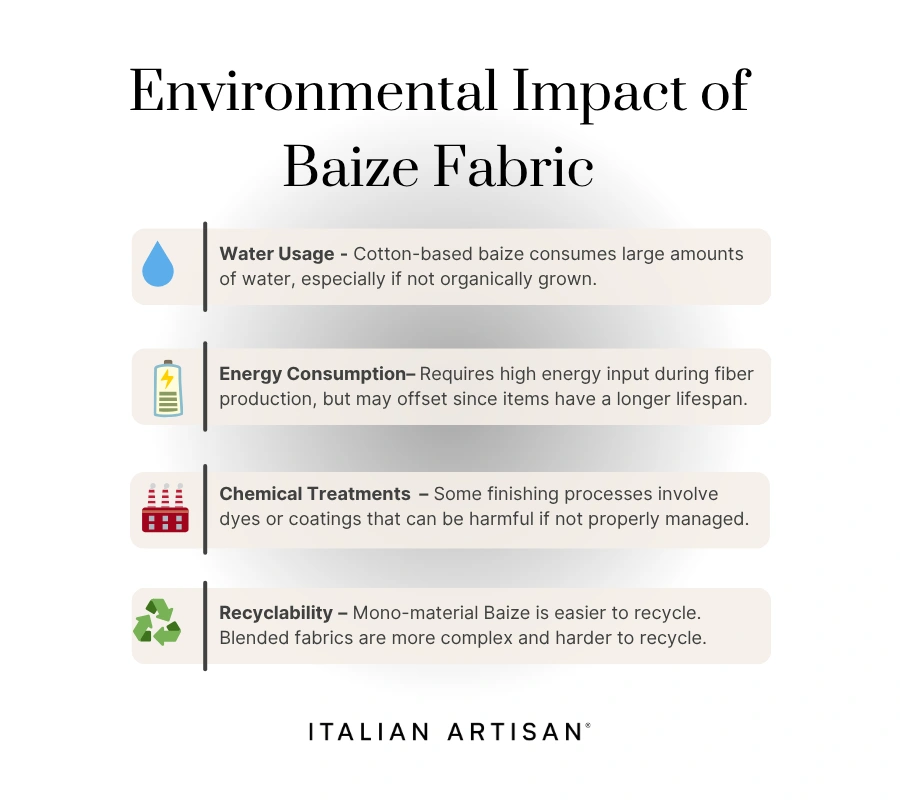
What to Look For
To reduce environmental impact, brands and consumers can prioritize:
- Biaze made from organic or responsibly sourced fibers
- Certifications like OEKO-TEX® or GOTS
- Manufacturers with clean water and energy practices
Italian producers, in particular, are investing in greener technologies and circular production models—making Made in Italy Baize fabrics a more sustainable option.
Exploring Price Points and Value for Money
The cost of Baize fabric can vary widely depending on the type of fiber used, the quality of the weave, and where it’s made. Whether you’re buying fabric by the meter or investing in a finished garment, understanding what drives the price helps assess its real value.
What Affects the Price of Baize Fabric?
- Fiber Content:
Wool and cotton Baize fabrics are typically more expensive due to the cost of raw materials and production. Synthetic blends (like polyester) are more affordable but may offer less breathability. - Origin of Production:
Baize fabrics made in Italy or other textile hubs often cost more because of higher labor standards, craftsmanship, and quality control—but they usually offer superior durability and finish. - Finishing Treatments:
Special finishes like wrinkle resistance, water repellency, or anti-pilling add to the cost but also enhance performance and lifespan. - Order Volume:
Like many textiles, Baize is more cost-effective when purchased in larger quantities. Custom colors or small-batch production will generally increase the price.

Is Biaze Fabric Worth the Investment?
Yes—especially for garments where structure, durability, and long-term wear matter. While it may cost more than lightweight plain weaves or synthetic-only alternatives, Biaze fabric offers better performance and a more refined aesthetic over time. For suiting, uniforms, or tailored jackets, it often delivers excellent value for money.
Conclusion
Baize fabric is a durable, twill-woven textile known for its structure, subtle texture, and versatility. Whether made from wool, cotton, or synthetic blends, it’s valued for its clean finish, wrinkle resistance, and lasting performance.
Used in tailoring, uniforms, and interior design, Baize offers a smart balance between elegance and durability. Choosing the right composition helps match the fabric to your specific needs—whether you’re looking for comfort, structure, or easy care.
FAQs
1. What is Baize fabric used for?
Baize fabric is commonly used in suits, blazers, uniforms, trousers, and upholstery due to its structure and durability.
2. Is Baize fabric breathable?
It depends on the fiber content. Cotton and wool Baize are breathable, while polyester blends are less so.
3. Does Baize wrinkle easily?
No. The twill weave offers natural wrinkle resistance, especially in wool or polyester versions.
4. Can Baize be machine washed?
Some blends can, especially cotton or polyester. Wool or viscose-based Baize typically requires dry cleaning.
5. Is Baize good for summer clothing?
Lightweight cotton Baize works for summer, but heavier versions are better suited for cooler seasons.
6. Is Baize the same as twill?
Not exactly. Baize is a type of twill fabric, but with specific structure and use cases, especially in formalwear.
7. How is Baize different from denim?
Baize is smoother, more refined, and lighter than denim, which is rougher and heavier.
8. Is Baize fabric sustainable?
It can be, especially when made with organic or recycled fibers and produced under responsible conditions.
9. Can Baize be used for upholstery?
Yes. Heavier Baize fabrics are durable and hold their shape, making them suitable for furniture and curtains.
10. Where is Baize fabric made?
Baize is produced globally, but Italian-made Baize is highly regarded for its quality, finish, and craftsmanship.




